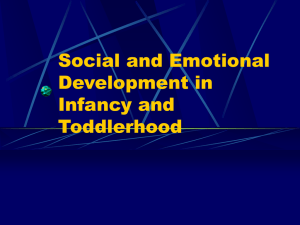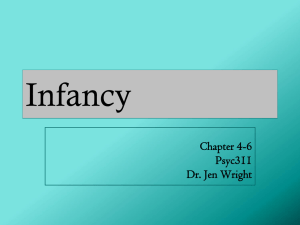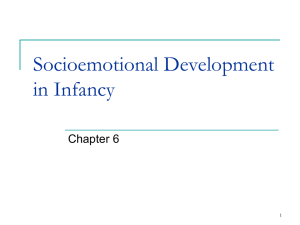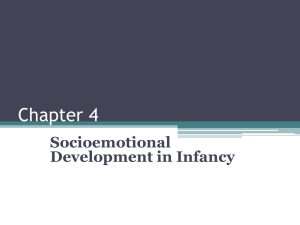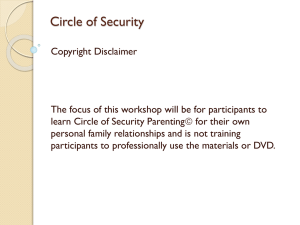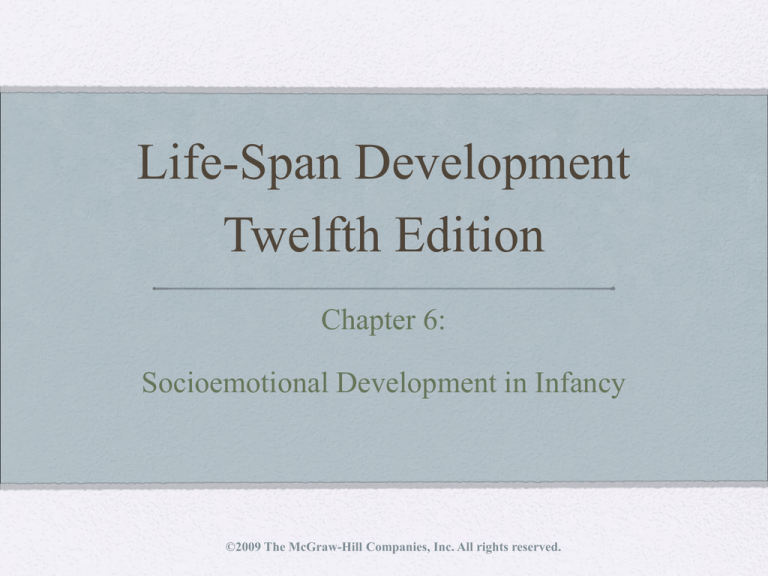
Life-Span Development
Twelfth Edition
Chapter 6:
Socioemotional Development in Infancy
©2009 The McGraw-Hill Companies, Inc. All rights reserved.
Emotions
• Emotion: feeling, or affect, that occurs when a person is
in a state or an interaction that is important to him or
her, especially to his or her well-being
• Biological and Environmental Influences:
• Changes in baby’s emotional capacities with age
• Development of certain brain regions plays a role in
emotions
• Emotions are the first language with which parents and
infants communicate
• Social relationships provide the setting for the development
of a variety of emotions
©2009 The McGraw-Hill Companies, Inc. All rights reserved.
Emotions
• Early Emotions:
• Primary Emotions: emotions that are present in
humans and animals
• Appear in the first 6 months
• Self-Conscious Emotions: require self-awareness
that involves consciousness and a sense of “me”
• Appear between 6 months and 2 years of age
• Ongoing debate about the onset of various
complex emotions
©2009 The McGraw-Hill Companies, Inc. All rights reserved.
Emotions
• Emotional expressions are involved in infants’ first
relationships
• Positive interactions are described as reciprocal or synchronous
• Crying is the most important mechanism newborns have for
communicating with their world
• Three types of cries:
• Basic cry
• Anger cry
• Pain cry
• Two types of smiling:
• Reflexive smile
• Social smile
©2009 The McGraw-Hill Companies, Inc. All rights reserved.
Emotions
• Fear is one of a baby’s earliest emotions
• Appears at about 6 months; peaks at about 18 months
• Stranger Anxiety: occurs when an infant shows a fear
and wariness of strangers
• Emerges gradually, first appearing at about 6 months of age
• Intensifies at about 9 months of age, escalating past the 1st
birthday
• Intensity of anxiety depends on:
• Individual differences
• Familiarity of the setting
• Who the stranger is and how the stranger behaves
©2009 The McGraw-Hill Companies, Inc. All rights reserved.
Emotions
• Separation Protest:
crying when the
caregiver leaves
• Due to anxiety about
being separated from
their caregivers
• Typically peaks at
about 15 months for
U.S. infants
• Cultural variations
©2009 The McGraw-Hill Companies, Inc. All rights reserved.
Emotions
• Caregivers’ actions influence the infant’s neurobiological
regulation of emotions
• As caregivers soothe, it reduces the level of stress hormones
• Swaddling
• Infant gradually learns how to minimize the intensity of
emotional reactions
• Self-soothing
• Self-distraction
• Language (2nd year)
• Context can influence emotional regulation
• How should caregivers respond?
©2009 The McGraw-Hill Companies, Inc. All rights reserved.
Temperament
• Temperament: an individual’s behavioral style and
characteristic way of responding
• Chess and Thomas’s Classification:
•
•
•
•
Easy child (40%)
Difficult child (10%)
Slow-to-warm-up child (15%)
Unclassified (35%)
• Kagan classifies children based on inhibition to
the unfamiliar
• Shows stability from infancy to early childhood
©2009 The McGraw-Hill Companies, Inc. All rights reserved.
Temperament
• Rothbart and Bates’s Classification:
• Extraversion/surgency
• Negative affectivity
• Effortful control (self-regulation)
• High-control children have successful coping strategies
• Low-control children are disruptive and intensely
emotional
©2009 The McGraw-Hill Companies, Inc. All rights reserved.
Temperament
• Kagan: children inherit a physiology that biases
them to have a particular type of temperament, but
this is modifiable through experience
• Biological Influences:
• Physiological characteristics have been linked with
different temperaments
• Heredity has a moderate influence on temperament
differences
• Contemporary view: temperament is a biologically
based but evolving aspect of behavior
©2009 The McGraw-Hill Companies, Inc. All rights reserved.
Temperament
• Gender and Cultural Influences:
• Parents may react differently to an infant’s
temperament depending on gender
• Different cultures value different temperaments
• Goodness of Fit: the match between a child’s
temperament and the environmental demands
the child must cope with
©2009 The McGraw-Hill Companies, Inc. All rights reserved.
Personality Development
• Three central characteristics:
• Trust: Erikson believed the 1st year is characterized
by trust vs. mistrust
• Not completely resolved in the first year of life
• Arises again at each successive stage of development
• Development of a sense of self
• Occurs at approximately 18 months
• Independence through separation and individuation
• Erikson: autonomy vs. shame and doubt
©2009 The McGraw-Hill Companies, Inc. All rights reserved.
Social Orientation
• Face-to-face play begins to characterize interactions at
2 to 3 months of age
• Infants begin to respond more positively to people than
objects
• Still-face paradigm
• Frequency of face-to-face play decreases after 7 months of
age
• Peer interactions increase considerably between 18 to
24 months of age
• Increased locomotion skills allow infants to explore and
expand their social world
©2009 The McGraw-Hill Companies, Inc. All rights reserved.
Social Orientation
• Perceiving people as engaging in intentional
and goal-directed behavior occurs toward the
end of the 1st year
• Joint attention and gaze following
• Social Referencing: “reading” emotional cues
in others to determine how to act in a particular
situation
• Emerges by the end of the 1st year; improves during
the 2nd year
©2009 The McGraw-Hill Companies, Inc. All rights reserved.
Attachment
• Attachment: a close emotional bond between two
people
• Theories of Attachment:
• Freud: infants become attached to the person that
provides oral satisfaction
• Harlow: contact comfort preferred over food
• Erikson: trust arises from physical comfort and
sensitive care
• Bowlby: newborns are biologically equipped to elicit
attachment behavior from caregivers
©2009 The McGraw-Hill Companies, Inc. All rights reserved.
24
Mean
hours
per
day
18
.
.
.
.
. .
.
12
.
.
6
0
Infant monkey fed on
cloth mother
Infant monkey fed on
wire mother
Hours per day spent
with cloth mother
Contact Time with
Wire and Cloth
Surrogate Mothers
.
.. . .. .. . Hours
per day spent with
wire mother
.
.
1-5
11-15
21-25
6-10
16-20
Age (in days)
©2009 The McGraw-Hill Companies, Inc. All rights reserved.
Attachment
• Four Phases:
• Phase 1 (birth to 2 months): infants direct their
attention to human figures
• Phase 2 (2 to 7 months): attachment becomes focused
on one figure
• Phase 3 (7 to 24 months): specific attachments develop
• Phase 4 (24 months on): children become aware of
others’ feelings and goals, and begin to take these into
account in forming their own actions
• Infants develop an internal working model of
attachment
©2009 The McGraw-Hill Companies, Inc. All rights reserved.
Attachment
• Strange Situation is an observational measure of infant
attachment
• Attachment Classifications:
• Securely attached: explores environment while using caregiver
as a secure base; displays mild discomfort when caregiver leaves
• Insecure avoidant: avoids caregiver; shows no distress/crying
when caregiver leaves
• Insecure resistant: clings to caregiver and protests loudly and
actively if caregiver leaves
• Insecure disorganized: disorientation; extreme fearfulness may
be shown even with caregiver
• Ainsworth’s research is criticized for being culturally biased
©2009 The McGraw-Hill Companies, Inc. All rights reserved.
Avoidant
Secure
Resistant
70
Cross-Cultural
Comparison of
Attachment:
Ainsworth’s Strange
Situation applied to
infants in three
countries in 1988
60
50
40
30
20
10
Percentage of
0
infants
U.S.
Germany Japan
©2009 The McGraw-Hill Companies, Inc. All rights reserved.
Attachment
• Interpreting Differences in Attachment:
• Attachment is an important foundation for later
psychological development
• Early attachment can foreshadow later social behavior
• Early secure attachment is not the only path to success
because children are resilient and adaptive
• Later experiences also play an important role
• Genetics and temperament play a role in attachment
differences
• Attachment varies among different cultures of the world
©2009 The McGraw-Hill Companies, Inc. All rights reserved.
Social Contexts
• The Family:
• Family is a constellation of subsystems
• Each subsystem has a reciprocal influence on the other
• Adjustment of parents during infant’s first years
• Infant care competes with parents’ other interests
• Marital satisfaction and relationship dynamics may change
• Reciprocal socialization: two-way interaction process
whereby parents socialize children and children socialize
parents
• Parent–infant synchrony: temporal coordination of social behavior
• Scaffolding: parental behavior that supports children’s efforts through
turn-taking sequences
©2009 The McGraw-Hill Companies, Inc. All rights reserved.
Social Contexts
©2009 The McGraw-Hill Companies, Inc. All rights reserved.
Social Contexts
• Maternal and Paternal Caregiving
• An increasing number of U.S. fathers stay home full-time
with their children
• Fathers can be as competent as mothers in caregiving
• Maternal interactions typically center on child-care activities
(feeding, changing diapers, bathing)
• Paternal interactions tend to be play-centered
• Fathers tend to be more involved when:
•
•
•
•
They work fewer hours (and mothers work more)
They are younger
The mothers report greater marital intimacy
The children are boys
©2009 The McGraw-Hill Companies, Inc. All rights reserved.
Social Contexts
©2009 The McGraw-Hill Companies, Inc. All rights reserved.
Social Contexts
• Child Care
• More children are in child care now than ever
before
• Parental-leave policies vary across cultures
• The U.S. grants the shortest period of parental leave and
is one of the few countries that offers only unpaid leave
• Type of child care varies
• Child care centers, private homes, etc.
• Low-SES children are more likely to experience
poor-quality child care
©2009 The McGraw-Hill Companies, Inc. All rights reserved.
Social Contexts
• National Institute of Child Health Study:
• By 4 months, ¾ of infants were in some type of child care
• Socioeconomic factors linked to amount and type of care
• Quality of child care:
• Group size, child–adult ratio, physical environment, caregiver
characteristics
• High-quality care resulted in better language and cognitive skills,
more cooperation and positive peer interactions, and fewer behavior
problems
• Quantity of child care:
• Extensive amounts of time in child care led to fewer positive
interactions with mother, more behavior problems, and higher rates
of illness
• Influence of parenting was not weakened by extensive care
©2009 The McGraw-Hill Companies, Inc. All rights reserved.

